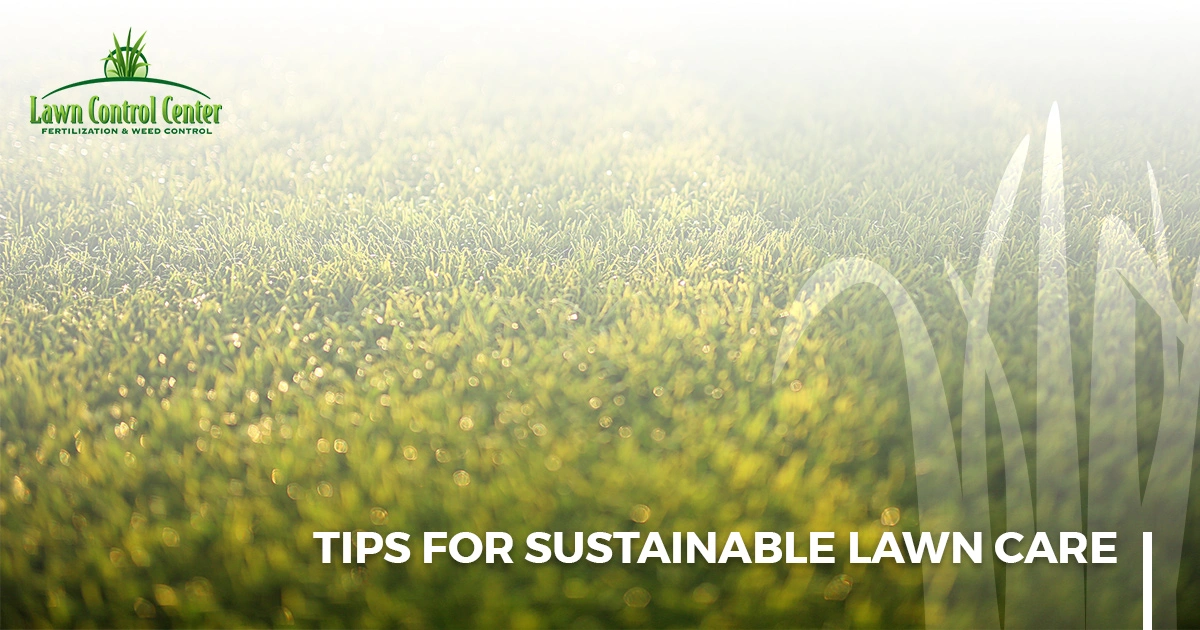Beautiful, lush green lawns do more than just look good. They help prevent erosion, reduce storm runoff, improve water quality, and help reduce air pollution. These benefits, however, come at a hefty cost. Some sources estimate that Americans spend roughly 30 billion dollars a year on lawn maintenance and use over 70 million tons of fertilizer and pesticides.
Given this massive expenditure, it is no wonder that sustainability is a growing trend in the lawn care world. In today’s blog, we here at Lawn Control Center would like to offer just a few lawn care tips to improve the sustainability of your lawn maintenance. When your lawn care practices become more sustainable, you can:
- Save money
- Help the environment
- Reduce energy usage and time required for maintenance
If you are in our service area and in need of lawn care services, do not hesitate to contact our team of professionals. From lawn fertilization to weed control to general lawn maintenance, our lawn care company takes pride in being able to handle it all.
Below are a few simple tips to improve the sustainability of your lawn care.
Test Soil
A soil test is the perfect way to find out what your lawn needs and doesn’t need. A simple test can reveal any deficiencies and whether or not you need to add nitrogen, iron, or other nutrients to enhance your lawn’s health. Sharing your soil test with your lawn care service providers can not only help develop the best possible lawn treatment plan, but it can also help give you the information you need to maintain your lawn in the most efficient way possible.
Embrace Local
Naturally, grasses that are indigenous to the climate in which you live are going to do better than non-native grasses. The same can be said for the type of grass you choose and how you plan to use it. Since grasses vary in how much water and nutrients they need, how much shade they can tolerate, and how much wear they can withstand, you want to find a grass that best suits your needs. Consult with your local garden center or lawn care professionals to help determine what type of grass will best accommodate your needs. Being matched with the most suitable grass will help optimize the efficiency of your lawn services.
Sharpen Mower Blade
The sharper your mower blades are, the more efficient your cuts will be. If you are not sure whether or not your blades need to be sharpened, you can look at the tips of grass. If the cuts are brown and ragged, then your blades are dull. Also, if you have never sharpened your lawn mower blades in all the years that you have owned your lawn mower, you can probably assume that you are due for a sharpening.
Don't Cut Too short
While mowing is important to both the appearance and health of your lawn, there is such a thing as cutting your grass too short. When you cut your grass too low, you inadvertently expose the surface roots, drying out the soil and reducing surface aeration. As a general rule of thumb, never cut more than a third of your grass off at one time. When you cut more than is necessary, you will invariably end up spending more trying to restore the condition of your lawn.
Adjust Watering
While watering is an essential part of maintaining a healthy and beautiful lawn, there is such a thing as watering too much. And in fact, overwatering may be worse than under-watering. Additionally, when you water your lawn try to avoid doing so in the heat of the day. A lot of daytime watering is lost to evaporation. Generally speaking, for most healthy lawns, one inch of water per week is sufficient.
Fertilize Wisely
Fertilizing your lawn once or twice a year is a great way to get your lawn in optimal shape. However, over-fertilizing your lawn can be damaging, and fertilizing at the wrong time, like say, during the summer, will be ineffective and not the most efficient use of your resources.
Use Low-Impact Weed Control
Ideally, you want to keep your lawn from being dependent upon chemical fertilizers. This, of course, is much easier said than done. However, it is important to remember that it is possible to develop a healthy lawn that is resistant to weeds and diseases. But until you get your lawn to that point, use pesticides and herbicides sparingly. And if you are using pesticide for weed control, opt for pesticides with low environmental impact.
As you can see, all of these tips are designed to create a lawn care plan where materials and resources are used in the most efficient way possible and in a way that has a positive impact on the environment. If you need assistance developing a sustainable lawn care plan, contact the professional lawn care team at Lawn Control Center. We are a full-service lawn care company servicing the greater Columbus and Cleveland area. Learn more about us and our services, and contact us today to schedule your lawn care.




Comments (0)
Thanks for your comment!
Thanks for your feedback! Your comments have been successfully submitted! Please note, all comments require admin approval prior to display.
Error submitting comment!
There is a problem with your comment, please see below and try again.